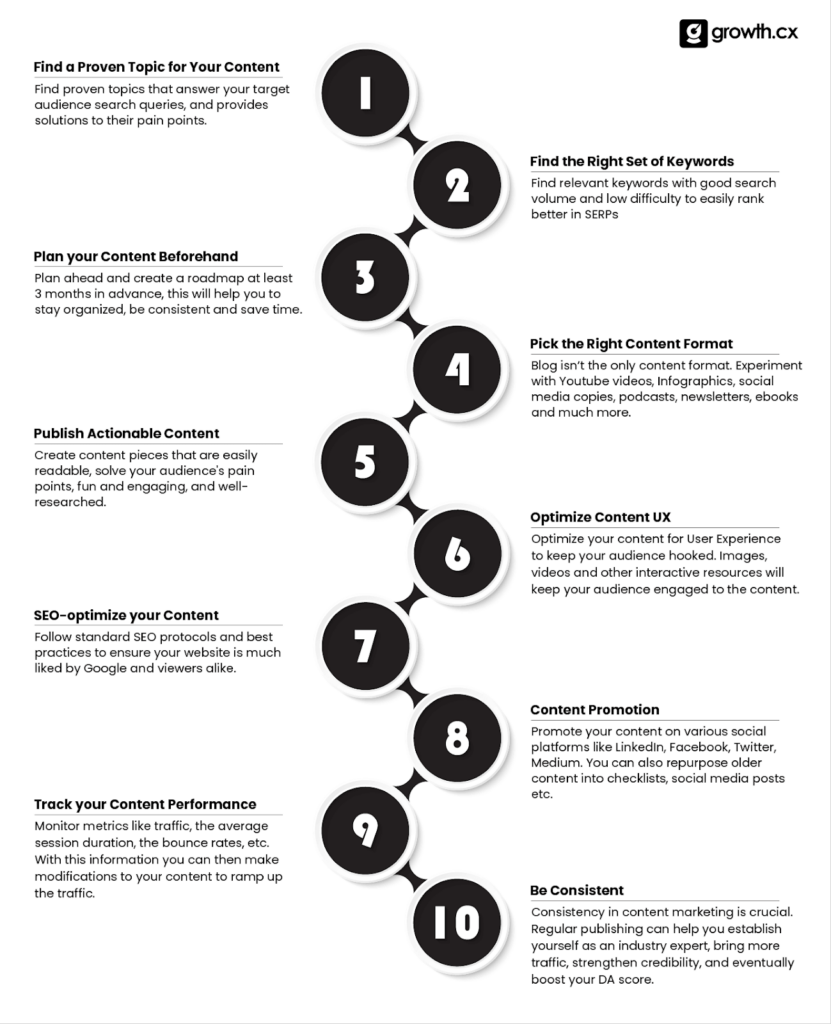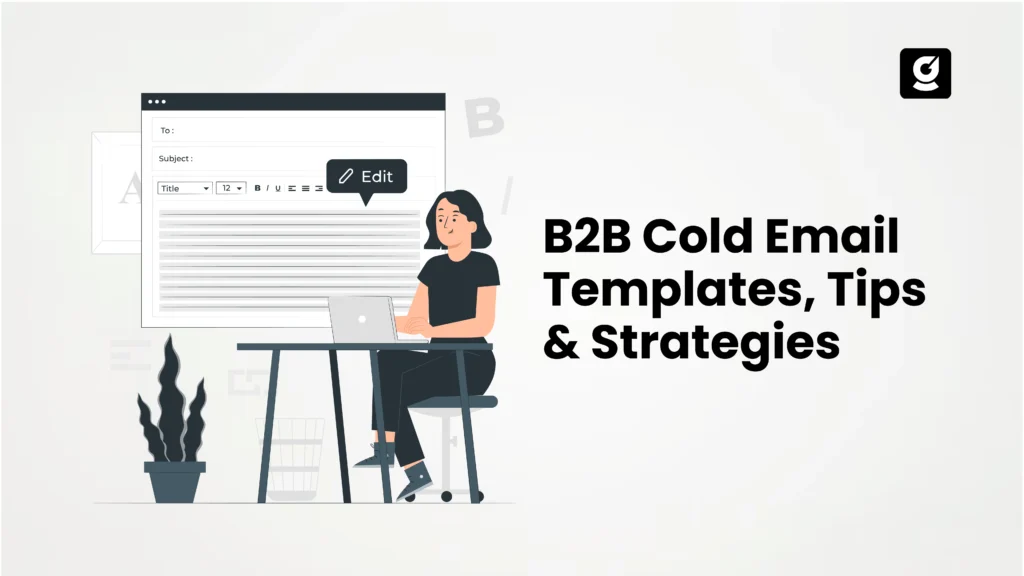Do you ever feel like no matter how hard you try, your B2B SaaS business just can’t seem to get the traffic it deserves? You’re doing everything ‘right,’ but your competitors just seem to be getting ahead of you. The truth is, that marketing a B2B SaaS product can be a real pain.
But fear not, my friend! The answer to your problems lies in the perfect content marketing strategy. It might sound like a buzzword, but trust me, it works.
Is content marketing just about writing a few optimized articles and publishing them? Well, not really. There’s a lot more to content marketing than meets the eye.
If you are a newbie, you might as well keep reading further because what’s below is the simplest yet most powerful content marketing strategy you’ll come across. And mind you, they aren’t just a ‘CTRL C + CTRL V’ from another random article you find online.
These are tried and tested strategies that helped our content team at growth.cx increase our clients’ traffic by 51%! So, that’s experience talking!
10 Simple B2B Content Marketing Strategies to Bring Steady Growth to Your SaaS Business
B2B SaaS Content marketing has become an inevitable part of businesses. It has become the most powerful part of inbound marketing and helps attract leads and close more deals.
If written in an engaging manner while complying with SEO, content marketing can bring thousands of visitors and ramp up conversion rates like never before. So without further ado, let’s dive deeper into some of the best content marketing strategies.

1. Find a Proven Topic for Your Content

Here we have listed some best possible ways to find the perfect topic for your content marketing.
Understand Your Target Audience
- Deep dive into your buyer personas and not just the demographic data. Look at their behavior patterns, motivations, and goals.
- Consider their typical buying journey. What information do they need at each stage to progress to the next?
- Knowing your audience inside out will help you generate topic ideas that resonate, connect, and ultimately convert.
To find a proven topic, you’ll need to find what your target audiences are searching for.
‘Are they looking for informative pieces?’ ‘Are they looking for a reliable solution?’ ‘Or do they want comparison pieces?’.
Competitor Research
Then, take a good look at your competition. No, we’re not advising you to copy their work but to learn and take inspiration. Ask yourself:
- What are they writing about?
- Which topics get the most engagement?
- Is there a popular topic they haven’t covered comprehensively?
Drawing insights from competitor content can expose gaps you can fill, or offer angles you hadn’t considered. It’s like finding a treasure map to the pot of content gold.
Trends
Now, let’s talk about the need to stay on top of content marketing trends. The SaaS world is rapidly evolving, with new solutions and features popping up almost daily. And your audience? They want to stay ahead of the curve. So should your content.
- Keep your finger on the pulse of the industry. Watch for emerging trends, new products, updates, and news.
- Consider tools like Google Trends, Twitter Trending Topics, or BuzzSumo to help you spot trending topics.
Remember, if you can catch a trend at the right moment and craft a valuable, relevant piece around it, you’re already on your way to the city.
Consult the Sales Team
Your sales team? Yes, indeed. Think about it. They are on the frontlines every day, interacting with potential customers, and listening to their problems, objections, and the solutions they are seeking.
- Collaborate with your sales team to understand what questions are frequently asked.
- Gather insights about customer concerns and barriers to purchase.
In short, your sales team holds a treasure trove of topic ideas. They just might not know it!
Data-Driven Insights
Are you leveraging data to drive your content decisions? If not, you’re missing out, big time! Look at the data you have from your existing content.
- What are your best-performing pieces?
- What’s common about them? Topic, format, length, keywords?
- Analyze. Learn. Repeat. Data doesn’t lie. It’s one of your most powerful tools for choosing the right topics.
Social Listening
And finally, lend an ear to social media. There’s an ongoing, sprawling conversation about your industry, products, services, competitors…just about everything. This chatter is full of content cues.
- Look for common questions, complaints, praises, and discussions around your niche.
- Tools like Brand24, Mention, or Hootsuite can make social listening a breeze.
- Check out online communities like Quora, Reddit, G2, etc., and analyze the discussions of your target audience. These are great places to find user-generated topics.
- Look at industry podcasts, tutorials, and other informative video content. And yes, do check out the comment section, that’s a goldmine of insights for you!
- Analyze competition and find out what kind of content works for them and what is that they are missing out on.
Leverage the aforementioned points, and you’ll see how it elevates your content marketing efforts.
2. Find the Right Set of Keywords
The next step is to find relevant types of keywords for your topic. For this purpose, you might want to use tools like Google’s Keyword Planner, Ubersuggest, Ahrefs, SEMrush, etc.
However, some of these are paid tools while those that are free or come with a free version have very limited functionalities. Once you pick your tool…
- You need to find your focus keyword. Input the main phrase of your topic into your tool, and you’ll find its monthly search volume and keyword difficulty, along with a list of suggestions.
- It’s not always necessary to select the exact phrase of your topic. If you see a keyword with higher volume and lower keyword difficulty, you can also choose that, provided it meets the user intent.
- Just finding the focus keyword won’t suffice. You need to tell Google that your article has delivered in-depth content on the particular keyword. So, you’ll have to find secondary, tertiary, and other keywords that pertain to the focus keyword.
- The secondary and tertiary keywords you picked must be closely associated with the focus keyword. You can use the keyword finder tools for the same.
- As for other keywords, you can rely on Google’s auto-suggest and related searches. These two aspects will tell you what your audience is specifically searching for around this topic. So, it’s very important to find those phrases and make content relevant to them, and results are 100% guaranteed.

3. Plan your Content Beforehand
Now, this point is supposed to be a given, but shockingly many content marketers do not give it enough importance. Planning the content as and when you write is not a good practice. Research is the foundation of content marketing. Let me elaborate.
When you research for a keyword, you’ll find pertaining keywords that are trending at the moment, and you will be able to make different content pieces for the topic, thus showing Google that your site has an in-depth idea about these topics.
Thinking of a random topic at the spur of the moment and then writing on it will not help. The reason is that you’ll not have the time to research further and find relevant topics that can support it (and increase the credibility of your site content). You won’t have a clear content roadmap to follow, which will hurt your marketing efforts.
So, plan ahead and make a roadmap for your content, at least 3 months in advance. This will not only help you build a reliable content profile but also enable you to stay organized, be consistent, and save time.
4. Pick the Right Content Format

Image Source – https://crystalclearcomms.com/most-popular-types-of-content-marketing/
A blog is not the only content format we have, right? There are different kinds of content formats. There are blog posts, landing pages, Explainer Videos, Infographics, social media copies, podcasts, newsletters, ebooks, whitepapers, case studies, and much more.
You need to find the content format that works best for you. Now, does that mean you have to stick to one content format? Absolutely not.
Go for multiple content formats that work best for you. Analyze your website data and identify the format that brings a good amount of visitors and engagement.
Now going for multiple content formats doesn’t always mean developing new content every time. Here’s what you can do
Repurpose the existing content: You could write an saas blog post, repurpose it into a YouTube video, an Instagram post, or create an infographic! Or you could plug your YouTube video into your landing page. Some strategic thinking can go a long way in content marketing.
5. Publish Actionable Content
Around 7 million blog posts are published on a daily basis. Yes, you heard it right. A whopping 7 million! So, how do you stand out among such intense competition? Of course, you will have to execute all our strategies right from 1 to 10.
But there’s something beyond all these strategies. Can you guess what it is?
It’s the quality of your content! If you guessed it right, congratulations. If not, well, you learn something new every day.
You could get all your SaaS SEO strategies right and still fail if you don’t have winning content that imparts value to the user. Always remember Google wants to give the best content to their users, and if the average spent time on your content decreases, you are simply going to be out of this competition!
So create content pieces that are actionable and well-researched. Use simple language, break down your content into easily readable formats, solve your audience’s pain points, make it more fun and engaging, provide examples, and minimize unwanted fluff.
6. Optimize Content UX
As mentioned earlier, it’s very much essential to keep your audience hooked to your content. The first step is definitely ensuring the content quality. However, there are a few more steps following it.
- Divide the content and categorize it under different subheadings. Let’s say the topic is SEO tools. Divide the content under subheadings, ‘What are the features of an ideal SEO tool’ ‘The best SEO tools’ etc. You can further divide the content into the tools’ pros, cons, etc.
- Break your content into easily-readable short paragraphs.
- Create a table of contents to help readers understand what your content covers. List down every subtopic along with jump links to that particular section. Adding jump links can help a lot of cause, remember, people do not have much time to spare. They want the easiest and fastest way to consume content.
- Add images, videos, and other interactive resources that will engage the audience and impart value.
So create content pieces that are actionable and well-researched. Here are some tips to make your content better.
- Use simple language,
- Add Table
- Use bullet points
- Use content brigades
- Utilize storytelling opportunities
- Add images and simple infographics
- Support your points with relevant statistics
- Add expert quotes
7. SEO-optimize your Content
We marketers should focus on on-page SEO with writing SEO focused content. So, what are the main points to keep in mind while optimizing your content for SEO?

- Keep track of your keyword occurrence. It needn’t necessarily be the target (primary/focus) keyword only. It could be keywords surrounding it. It’s always a good practice to ensure that your target keyword appears around 0.5% – 1% times of the total word count BUT only if possible. Do NOT stuff keywords into your content. It can affect the content quality and user experience. Also, Google can penalize you. Honestly speaking, your content is bound to have the pertaining keywords if you do your research around it and write it genuinely. Just sayin’!
- Do try to include your primary keyword in the first 150 words of your content. This is because Google tries to match the given query after reading the first few lines of your content. Again, do NOT stuff the keyword.
- Optimize your Meta Title and Meta Description. Ensure it contains the target keywords and is curated in a catchy style. Your meta title shouldn’t exceed 55- 60 characters, and your meta description shouldn’t exceed 155 – 160 characters. If they do, only a part of your title and description will appear in the SERP.
- Position keywords in the H1 tag ( the main headline of your content) and in the H2 tags (subheadings) along with the body of the content.
- The URL should be short, and meaningful and should contain the primary keyword. Try to keep the length under 75 characters.
- Interlink content. Add the links of your existing content to your new content. This way, you can pass the link juice to the old content and even send users to the content location. Once published you can also link the new content to high-performing content to get the same benefit.
- Link helpful external resources from credible sites with good domain authority. It not only proves to be helpful for the readers but also enhances the credibility of the content. However, make sure that you don’t link to any competitor sites unless absolutely necessary.
8. Content Promotion

Sadly, this step is often overlooked. Just publishing the content won’t do. To attract more visitors, you should promote it across different social media platforms, the strategy is called social media marketing.
- Of course, sharing your content on social media is one way to go about it. However, just dropping the link on such platforms may not bring the expected results. You might want to repurpose the content, make it into videos or posts, and then add the link. You can also boost these posts if necessary.
- Promote your content through Content Roundups. Roundups are basically blogs that list out the best content of the week from a particular niche. So, get in touch with roundup representatives of your niche and request them to include your content link.
- Promote your content in email newsletters. Let your subscribers know that you’ve published helpful content. Since your subscribers are either your customers or your target audience, they are bound to click on it 8 out of 10 times.
9. Track your Content Performance
So, now you’ve published your content and promoted it. What next? You have to track the performance of the content. You need to monitor the traffic that it brings, the average session duration, the bounce rates, etc.
This way, you can find out if: your content is bringing enough visitors, are the numbers increasing, are people spending time on the content, and more. You can then make the needed modifications to your content to ramp up the traffic.
However, it usually takes around 1-3 months to get a clear idea of how your content is performing. It is advised to keep track of the data every week.
Further Read: 15 Do’s And Don’ts Of Content Marketing Strategy & Writing
10. Be Consistent
It is very important to publish content pieces consistently and scale your content marketing efforts. We would recommend you publish at least one piece every week. Regular publishing can help you establish yourself as an industry expert. Moreover, you will have more indexed pages, which in turn will bring more traffic and strengthen credibility, which will eventually help in building your DA score.
However, do not get trapped in that mad frenzy to publish as many posts as possible and totally forget about the quality of your content. Quality over quantity, anytime!
Looking to find the perfect content marketing agency to take your B2B SaaS business to the next level? Check out the blog – Top 10 B2B SaaS Content Marketing Agencies in 2025
Winding Up
The methods used to market content are continuously changing as per changes in search engine algorithms and audience demands, but a few things will remain.
Developing reliable and genuine content, improving user experience, and leveraging data will be the core of content marketing, no matter what. So, make it a point to deliver quality and understand your target audience; the rest will fall in place.
Anyhow, I hope our B2B SaaS content marketing strategies help you bring the needed change to boost your traffic to your SaaS website.
We at growth.cx have a team of professionals experienced in SaaS startup growth. Our experts have worked with over a dozen customers growing relevant website traffic and MQLs, SQLs, and driving high MRR.
Our mission is to reduce the number of startup failures by doing what we do best – Marketing! So contact us today, and we can work together to help you save time and money and empower you to do what you do best – Creating wonderful products and user experiences!
Happy Marketing!
FAQs
What are the content strategies of SaaS marketing?
SaaS marketing uses content strategies, such as writing articles, sharing success stories, hosting webinars, and more. It also leverages social media platforms to connect with potential customers and build trust.
Write about the benefits of SaaS content marketing?
It helps businesses get noticed, attract new customers, explain their products clearly, and build credibility as experts in their field.




